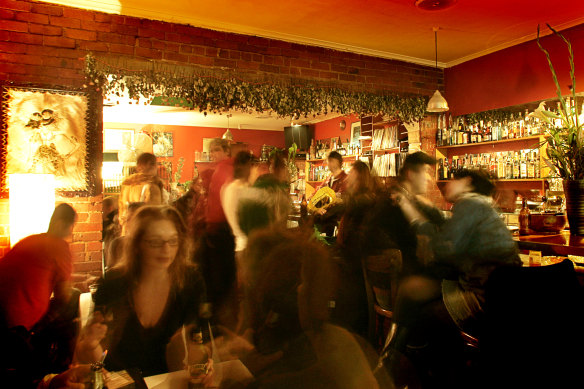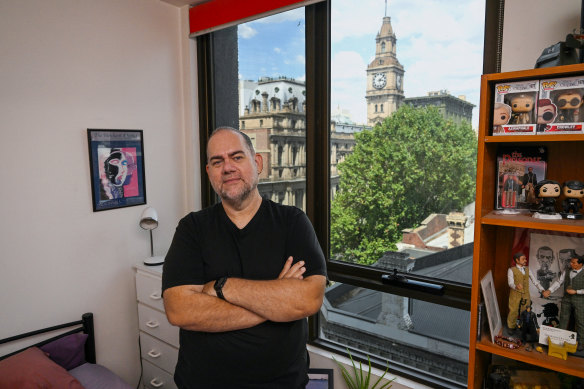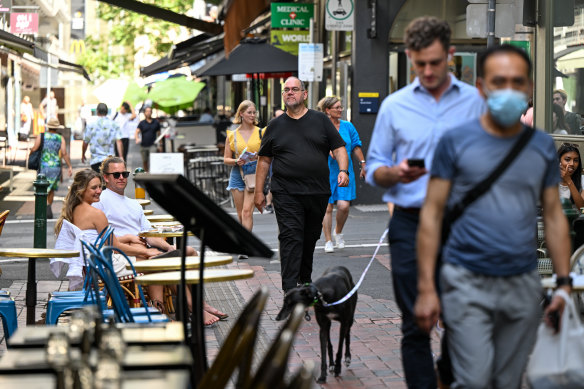This was published 1 year ago
Opinion
I’ve lived in Melbourne’s CBD for 20 years. Here’s what’s changed
Tim Richards
Travel writerCoffee at Little Mule, or a beer in the strange loading-zone jumble that was St Jerome’s. A pastrami roll and music played off vinyl at Rue Bebelons. Hardware picked up from Bunnings on Bourke Street. Buying a magazine from McGills on Elizabeth Street before heading up Little Bourke past John Donne & Son’s map shop to that Iranian restaurant near Hardware Lane (even I can’t remember its name).
This is what living in the Melbourne CBD for the past 20 years has gifted me: a strange mental muddle of cafes, shops and bars that have come and gone, surviving as ghosts in the memory of a long-term city resident.

Lost Melbourne gem Rue Bebelons, pictured in 2005. It closed in 2013 due to a development on the site.Credit: Michael Clayton-Jones
As Cara Waters wrote on Wednesday, since the pandemic the city centre is shifting from a place of business to a place where people live, and live it up. An increasing number of people are likely to base themselves in the city centre. So what’s it like living here?
At noon on February 28, I’ll have lived in the Melbourne CBD for exactly 20 years, in an apartment within a converted office block on the corner of Elizabeth and Little Bourke Streets, opposite the GPO. When my wife Narrelle and I made the move from Richmond in 2003, we thought we were moving into the big city. To our surprise, we moved into a village.
Over time, our patch of the CBD was revealed as sharing the characteristics of a country town. There were plenty of big businesses – Myer just over the road, for example – but also many small businesses run by their owners, who we got to know. Some are still around now, for example, Tarsem Singh at the nearby 7-Eleven, who’s been meeting our last-minute food shopping whims for two decades.
Other local heroes include Stephen Johnson and Sabrina Santucci, the husband-and-wife duo who originally co-owned Federal Coffee Palace cafe in the GPO building’s colonnade and then opened Whitehart, a quintessential Melbourne laneway bar in a former parking lot off Little Bourke Street. I’ve been dealing with the optometrists just along Elizabeth Street for the entire 20 years, and there’s a shoemaker past Hardware Lane who has been there as long.

Writer Tim Richards has lived opposite Melbourne’s GPO for 20 years this month.Credit: Joe Armao
Though it initially lacked supermarkets and lending libraries, the CBD of 2003 had more diversity of shopping than it does today, with rising commercial rents hollowing out its variety. Over time, closed businesses seemed to be replaced by one of two things: food or fashion. Nowadays the CBD has few newsagencies, fish and chip shops, launderettes, hardware stores or second-hand bookshops. We do have a lot of bubble tea shops.
People often ask me what it’s like to live in the city. To paraphrase Dickens, it’s the best of places and the worst of places. On Friday and Saturday nights the noise can be a pain, though if you live in the city you expect that. Maintenance (roads, drains, tram tracks, whatever) late on weeknights is far more annoying. The horrific episodes of tragic deaths due to drug-fuelled driving or terrorism were traumatic and heart-rending. And during the lockdown era the Melbourne CBD morphed from being the best place to live to the worst, a grim place of locked doors and empty laneways.
Balanced against this are the many positives we take for granted. Everything we could need to buy is available within a few blocks; it’s easy to walk, and to ride free trams; and we’re at the hub of the public transport network so there’s no north/south of the river shibboleth to contend with. As a travel writer I love being at the heart of the city’s food and culture, which helps me notice trends I can write about while they’re fresh. There’s a lively vibe to the place that speaks of potential, partly thanks to the youthful energy of our international students.
What of the future? It seems that CBDs everywhere will need to transition partly away from office work, toward being greater social hubs. Luckily the Melbourne CBD is already on this road, though I worry that decision-makers are failing to learn from the latest bold international visions of what a city centre can be. Australia has a housing crisis and the CBD is a convenient place to live.

Richards strolls his local laneways.Credit: Joe Armao
It’s not easy to convert office blocks to residential but it can conceivably be done –already New York is looking at adapting planning provisions to enable this. No one should sacrifice basic living standards, but such clever re-use would be a worthy challenge for our architects, designers and politicians; as would the increased pedestrianisation of the CBD, a concept which has faltered as the pandemic has eased. And perhaps governments – local and state – could buy empty office blocks then lease them out at reasonable rates to artists and other creative folk, counteracting some of the “poshification” of the CBD.
After 20 years here I’m bonded to Melbourne; its triumphs and failures are my triumphs and failures, my heart beats in time with the chimes of the GPO clock and resonates with the ding of tram bells. I suspect the CBD’s best future lies in community, and in becoming yet again a crucible in which its residents, business owners, workers and visitors can forge the next iteration of Marvellous Melbourne. If I last that long, I’m in for the next 20.
The Opinion newsletter is a weekly wrap of views that will challenge, champion and inform your own. Sign up here.
More original opinions
Home invasion: Former Victorian Attorney-General and now director of the Centre for Innovative Justice, Rob Hulls, had his family home invaded while everyone was sleeping. He would like to meet the criminals and ask them why.
Enough with private schools: After a multitude of private school scandals Jenna Price calls to defund them all now and to also “examine the values these schools teach to an ever-increasing number of students enrolled”.
Death as a teacher: When Waleed Aly’s mother-in-law Jan was dying, he found these last moments to be beautiful and harrowing. “It’s also one of the most clarifying. The moment of death takes our vast, complex lives, and reveals them to be simple.”